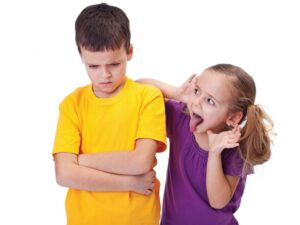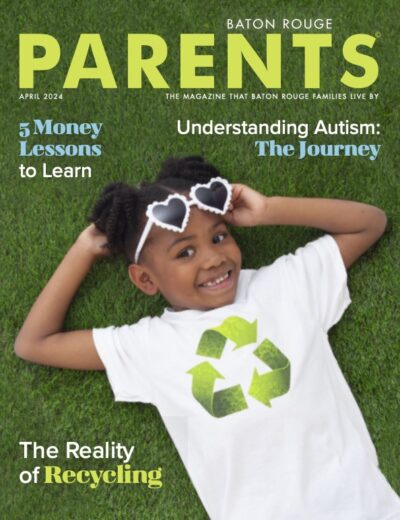
Is Teasing Bullying?
“Oh honey, I'm only teasing,” I say, smiling as I ruffle my six-year-old's thick thatch of blonde hair. He's annoyed that I'd gently ribbed him about the adorable cowlick on his head, and his need for a haircut. “Teasing isn't allowed at school. It's bullying,” he says with a grave look in his blue eyes.
This stops me in my tracks. Is playful teasing really the same as bullying? I’d mostly thought of teasing as a form of affection, especially within the family and with close friends.
Prosocial teasing.
Because the line between teasing and bullying can be blurry, many schools adopt zero-tolerance policies for both behaviors. Nonetheless, the ability to recognize and respond appropriately to light-hearted teasing is a valuable social skill.
Communication researcher Carol Bishop Mills, Ph.D., finds that the lighter side of teasing benefits our social lives by building and strengthening relationships and helping us navigate conflict. But teaching youngsters to recognize the differences between kidding and tormenting isn't easy.
In general, kids grasp the concept of affectionate teasing around age 10, Mills says. (Although, she adds, a child who is accustomed to good-natured kidding by parents may understand it earlier).
Affectionate teasing can create bonds and provoke good-natured laughter. Amanda Ott, school counselor at Denham Springs Freshman High has observed, “I see kids all the time at lunch joking and teasing between friends. I think this can be a positive thing because it makes the students feel accepted and part of a group. But, there is a line that can be crossed and even light teasing can turn into something more that can cause hurt feelings.”
Context and the nature of the relationship is key to understanding the meaning behind words. “When kids get teased, they tend to focus on the negative or challenging content,” Mills says. “Try to get them to take the perspective of others by asking, ‘What do you think Reece was doing?’ and talk through that.”
Discuss nonverbal cues that the other child exhibited. Ask questions like, “Was he laughing? Was he trying to play? Did he look mean when he said it?” Then, discuss teasing from your child’s point of view. “When you teased Leila, did you want her to cry? …Oh, you were playing, maybe Reece was playing too!” Mills says, “It'll take several attempts. It's not an overnight process.”
When teasing morphs into bullying.
Of course, youngsters also need to recognize when teasing isn’t playful. “If it hurts emotionally, socially, or physically, it's not funny,” says Deb Woodard, licensed professional counselor and certified school counselor. “If persistent, it can become what is formally identified as bullying.”
Point out body language and verbal signals that indicate that the target of the tease isn't happy. “You can usually tell if it is teasing/joking by the other kid’s response. There is definite body language that shows if a kid is okay with the teasing or if it has crossed the line. Bullying is when picking on or making fun of becomes constant and unwanted. Most times, it comes with one student who has more ‘power’ picking on a student who cannot defend themselves,” Ott says. Role-model, role-play and discuss situations as they arise. And respect your child's personal boundaries if he doesn't want to be teased about something–even if it starts out playfully.
“Even children who are too young to identify and express hurt feelings verbally, may cry or physically push away those who think they mean well,” Woodard says.
Build resilience.
Arm your child with skills to assertively manage put downs. Author and educational psychologist Michele Borba suggests firm statements like: “I want you to stop teasing me” or “Why would you say that?” If teasing continues, raise the possibility with your youngster that the remarks may not really be about them, but about the teaser.
“Kids tease because they’re playing with words (rhyming), exploring new ideas (boyfriend/girlfriend), pointing out differences (height, hair color, glasses, etc.) or to exert peer pressure,” Mills says.
While teaching kids to stand up for themselves and confidently express their feelings builds resilience, encourage them to immediately seek a trusted, safe adult if they ever feel scared or threatened. Ott adds, “I like to focus on helping the victims by showing them they have a voice and have power over their bullies by stepping up and coming to me or a teacher or administrator.” ■
Additional Resources:
Raising an Emotionally Intelligent Child by John Gottman
Masterminds & Wingmen: Helping Our Boys Cope with Schoolyard Power, Locker-Room Tests, Girlfriends, and the New Rules of the Boy World by Rosalind Wiseman
Queen Bees & Wannabes: Helping Your Daughter Survive Cliques, Gossip, Boyfriends, and the New Realities of Girl World by Rosalind Wiseman
UnSelfie: Why Empathetic Kids Succeed in Our All-About-Me World by Michele Borba, Ed.D.





